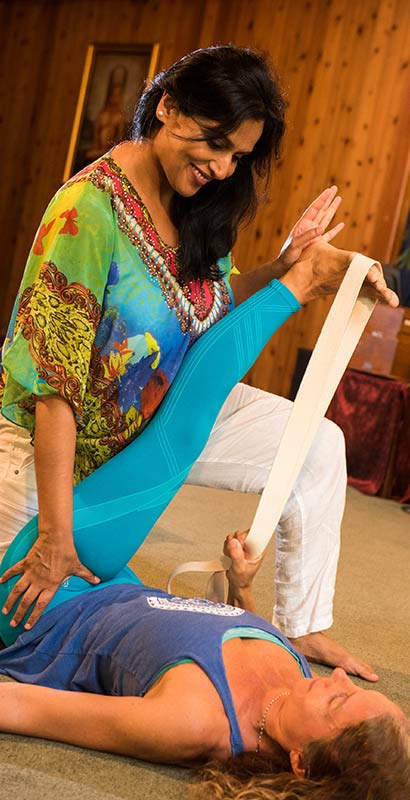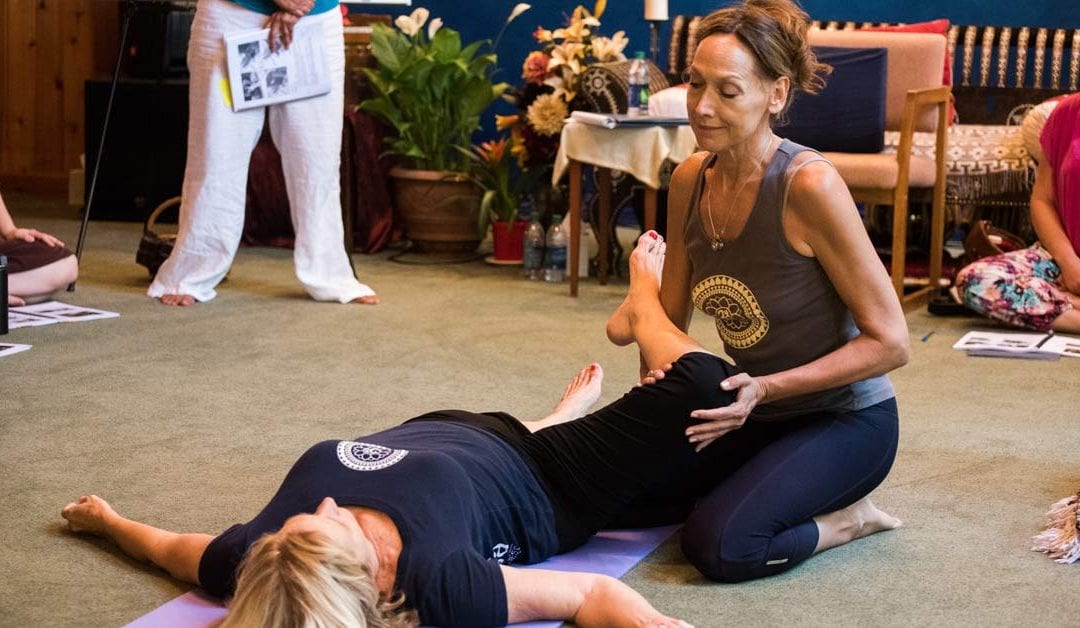Yoga Therapy: Working with the Psychology of the Body
Often, when we think of Yoga, we envision people contorting their bodies into crazy pretzel-like positions or hot, sweaty stamina building classes. While this kind of Yoga has become popular in Western society, recently another version of Yoga has taken root: Yoga Therapy. And for good reason.
Yoga Therapy is uniquely effective because it works with the psychology of the body, helping us release blocked feelings and emotional sensations that are the true source of our suffering.
When I first discovered Yoga Therapy, I was a clinical psychologist nearing the end of a 16-year career with the Federal Bureau of Prisons. That included a work stint at the Federal Supermax prison in Florence, Co., which houses some of the country’s most dangerous inmates. I realized I was a “Type A” personality and that I had become rigid, both physically and emotionally, to protect myself. I had a propensity to keep people at arm’s length and upheld strict boundaries.
From my first Yoga Therapy session, I had a huge release and let go of so much of my rigidity. That helped me soften around life a little bit. It was really the beginning of my journey.
Yoga brings healthy balance to the body by stimulating the parasympathetic nervous system and creating relaxation that improves blood flow to the digestive system, brain and extremities. Relaxation offsets the ‘fight or flight’ response of the sympathetic nervous system – the other half of our autonomic nervous system that’s activated by threats or emergencies.
How Yoga Therapy Helps Ease Burnout and “Sympathetic Overdrive”
Many of us are spending too much time in “sympathetic overdrive,” says Dr. Ina Stephens, a specialist in pediatrics and medical education at the University of Virginia Medical Center in Charlottesville, Va. who published a yoga therapy study in 2017. This chronic stress can contribute to cardiovascular disease, suppress immunity, exacerbate inflammatory diseases, impair memory, increase anxiety and fear and lead to depression and sleep disorders, Stephens said. Her study and many others have shown that Yoga helps to regulate blood glucose levels, improve musculoskeletal ailments, lower blood pressure and maintain a healthy cardiovascular system. It can also increase mental energy and positive feelings, and decrease negative feelings of aggressiveness, depression and anxiety.
The Healing Energetics of Yoga Therapy
But Yoga Therapy isn’t just a blanket term for all things Yoga. The Yoga Therapy I’m talking about works on a very subtle level; the body’s life force energy. In Chinese medicine this energy is known as

Pictured: Kamini Desai, PhD. demonstrating a strap assisted stretch in I AM Yoga Therapy™ Training course
Photo Credit: Thompson Brand Images
Chi. Japanese mystics refer to it as Ki (as in Reiki). In Yoga, it’s called Prana. It’s the energy that enlivens the physical body. It’s the divine intelligence that fires the neurons and secretes the hormones. Without Prana, there is no life.
In Yoga Therapy, blocked energy (Prana) is seen as the cause of all maladies. Once that energy is cleared to flow freely, the body and mind will be restored to order. It’s different from psychotherapy (or talk therapy), which focuses on thoughts and emotions. Psychology works at the level of the ego, or the personality, which can help us achieve a sense of life mastery. Yoga Therapy not only restores the body and mind, which can help us master life, it helps us recover our true nature – the person we are meant to be. Whereas psychology is about life mastery, Yoga Therapy is about that and liberation from the ego.
Everything we experience in life is a movement of energy that is meant to flow in to, through and out of us. We experience this energy not just through our senses, like touching, hearing or seeing, but also through a sensation felt deep within our body.
Emotions are sensations that drive thoughts in our minds. When we feel angry, fearful, sad, rejected, abandoned, or even happy, we feel a sensation in our body. Recall, for example, the gut feeling you may have experienced when someone threatened your job, or when your lover broke up with you. Sensations are always there, but most of us brush them off.
One of my earliest breakthroughs occurred in a Yoga Therapy session where I adopted a pose to stretch my haunches and release the tightness in my hips. Suddenly an enormous sadness swept through me. I didn’t know why I was sad. My mind started to search for a story to help it make sense. But, by this time, I knew that thinking wasn’t the answer.
Often, our feelings are so overwhelming we shut them down. We pass off the problem to our mind, where it’s easy to get caught up in analyzing issues to death. When we avoid the emotional sensation, we block the energy’s natural flow. It begins to circle in the body, growing more dense until it gets stuck.
In Yoga Therapy, we learn to locate, feel and release the bodily sensation tied to the emotional experience. We might access it through a Yoga posture, breathing techniques, or by revisiting the traumatic experience. All can help us find patterns and traumas we experienced years, decades, or perhaps even lifetimes earlier.
Once we sit with that sensation awhile and allow ourselves to feel it, the energy is free to move and typically does so rather quickly. As we become more adept at finding sensations in the body, we expand our capacity to sit with these intense sensations. Over time, we can learn how to access and move the energy ourselves.
This is how Yoga Therapy restores our physical, emotional and spiritual balance. From shifts in our overall wellness to shifts in our perspective, relationships and reactions, the results can be “sensation-al”!
Footnote: Stephens, Ina. 2017. “Medical Yoga Therapy.” Children 4, no. 2: 12.

Article by Chitra Marie Bailey
“Chitra” Marie Bailey, Psy. D. is a senior faculty member at the Amrit Yoga Institute in Salt Springs, Florida where she is a trainer in the I AM Yoga Therapy™ 800 Hour Curriculum and I AM Yoga Nidra Professional Trainings. She has a Doctorate in Clinical Psychology and spent 16 years in her first career as a psychologist. She holds several Amrit Method certifications including I AM Yoga (ERYT-500), Yoga Nidra, and Yoga Therapy. She is a certified member of the International Association of Yoga Therapists (C-IAYT). A Yogi through and through, Marie fell in love with the Amrit Methods when she first met Gurudev and his daughter Kamini in 2009. Marie is a practicing Yoga Therapist, Yoga Nidra facilitator, and Yoga teacher. She currently lives in Chandler, AZ.
This article was originally published in Arbus Magazine Oct/Nov 2018, pg. 32 edition and has been adapted for this blog by the author.
